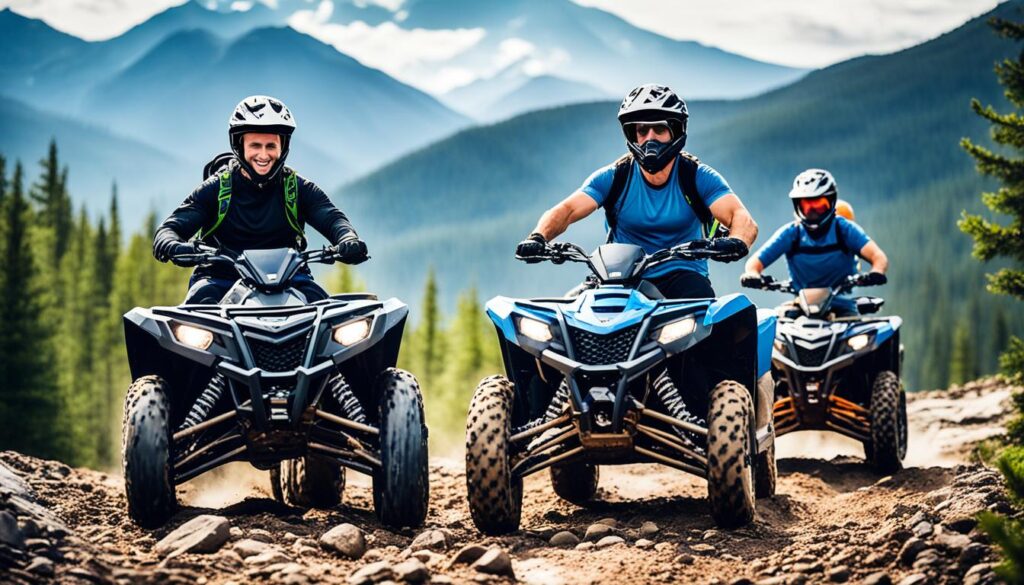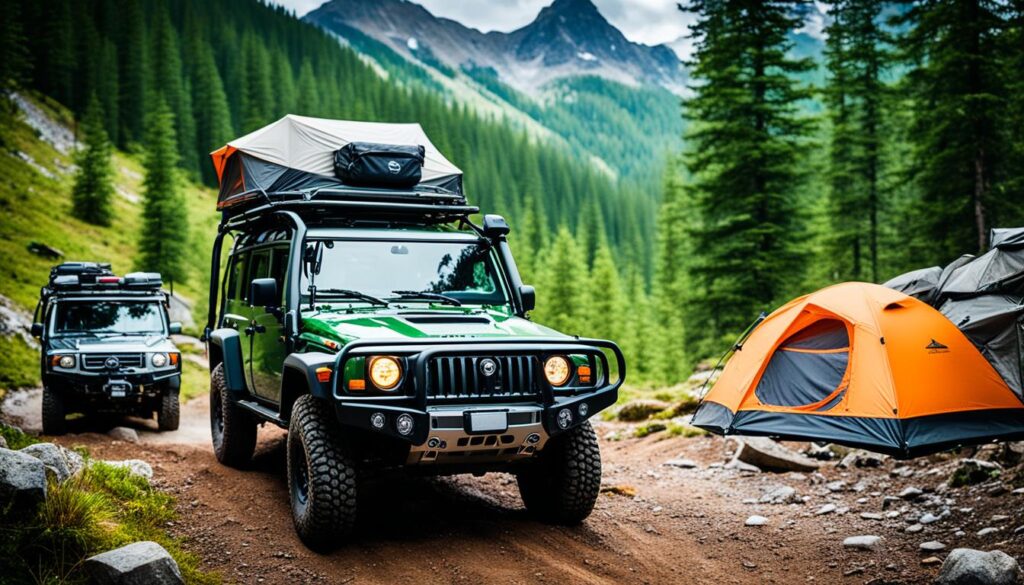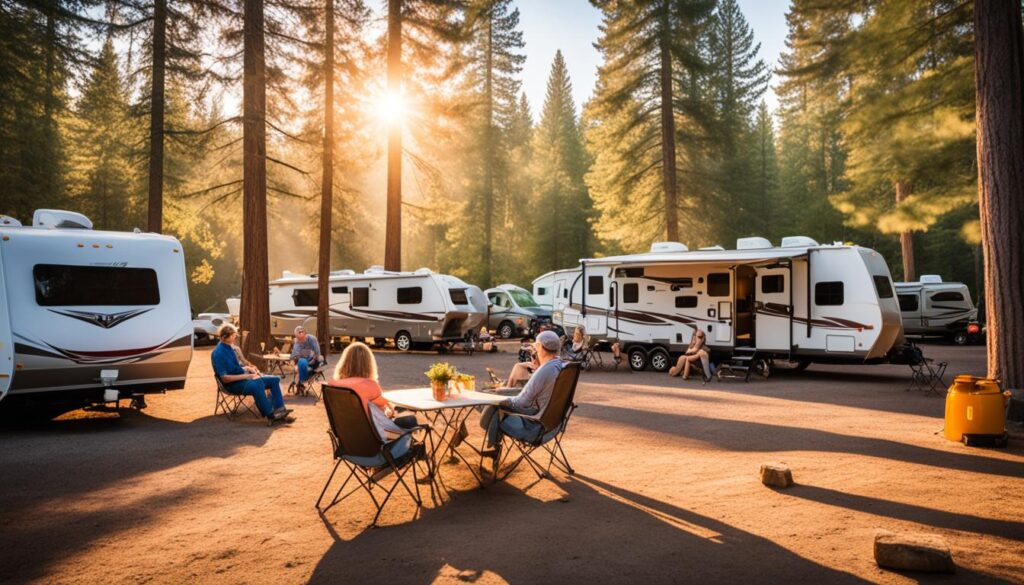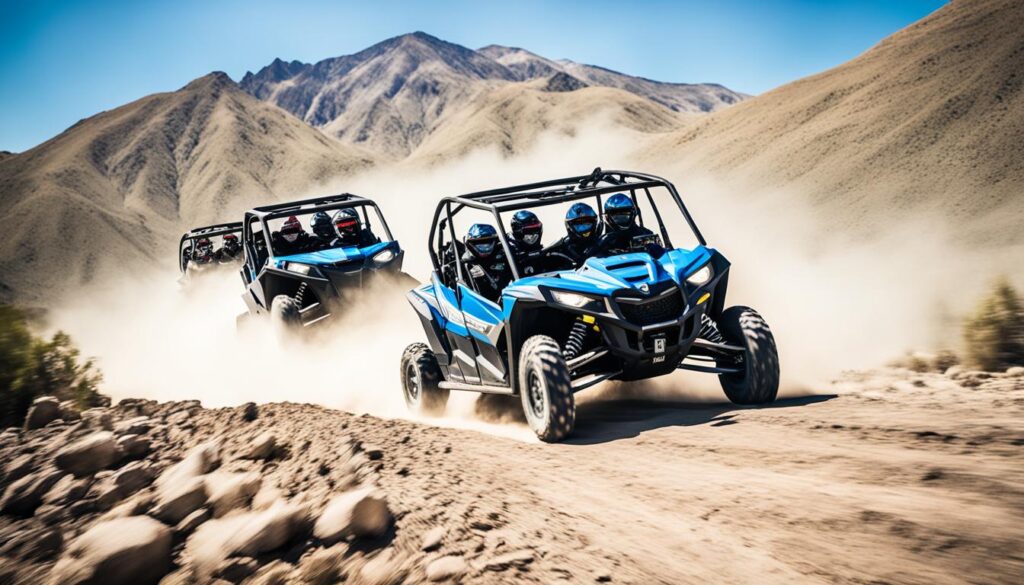If you’re new to ATVs, there’s a lot to learn before you fire up your ride and hit the trails. As a beginner, it’s essential to prioritize safety, familiarize yourself with the basics, and develop the necessary skills for a thrilling and enjoyable ATV experience. In this beginner’s guide to ATVing, I’ll share valuable tips and information to help you get started on your ATV adventure.
Key Takeaways:
- ATVing for Beginners: Essential Tips & Basics
- Prioritize safety and educate yourself on ATV safety basics
- Invest in hands-on ATV safety training
- Wear appropriate protective gear for safe riding
- Learn how to effectively use the throttle on your ATV
Contents
Know Your ATV Safety Basics
As a beginner in the world of ATV riding, it’s important to familiarize yourself with the ATV safety basics to ensure a safe and enjoyable experience. Here are some essential tips and advice to keep in mind:
Choose the Right ATV Model
Starting with a simple and appropriate ATV model is key for beginners. Opt for a model that is easy to handle and suits your skill level. This will help you build confidence and develop your riding skills gradually. Popular ATV brands that offer beginner-friendly models include Yamaha, Honda, and Polaris.
Read the Owner's Manual
Before hitting the trails, take the time to thoroughly read the owner’s manual of your ATV. This manual provides important information about the ATV’s features, controls, and maintenance requirements. Understanding your ATV’s capabilities and limitations will help you ride safely and avoid unnecessary risks.
Ensure Solid Footing
Having a stable and secure footing is crucial when riding an ATV. Always wear appropriate footwear with non-slip soles, such as sturdy boots, to maintain proper control over the ATV. Avoid wearing open-toe shoes or sandals, as they can increase the risk of accidents and injuries.
Take an ATV Safety Training Course
Enrolling in an ATV safety training course is highly recommended for beginners. Organizations like the ATV Safety Institute offer comprehensive training programs that cover important topics such as riding techniques, safety guidelines, and trail etiquette. These courses provide valuable knowledge and skills that will contribute to your safety on the trails.
Stay Off the Street and Observe Local ATV Restrictions
When riding an ATV, it’s important to stay off public roads and always use designated trails. Riding on public roads can endanger yourself and other motorists. Additionally, be mindful of any ATV restrictions specific to your area, such as age restrictions, trail closures, or specific safety requirements. Stay informed and ride responsibly.
By following these ATV safety basics, beginners can lay a solid foundation for their ATV riding journey. Prioritizing safety and taking the necessary precautions will not only enhance your experience but also ensure that you can enjoy ATVing for years to come.
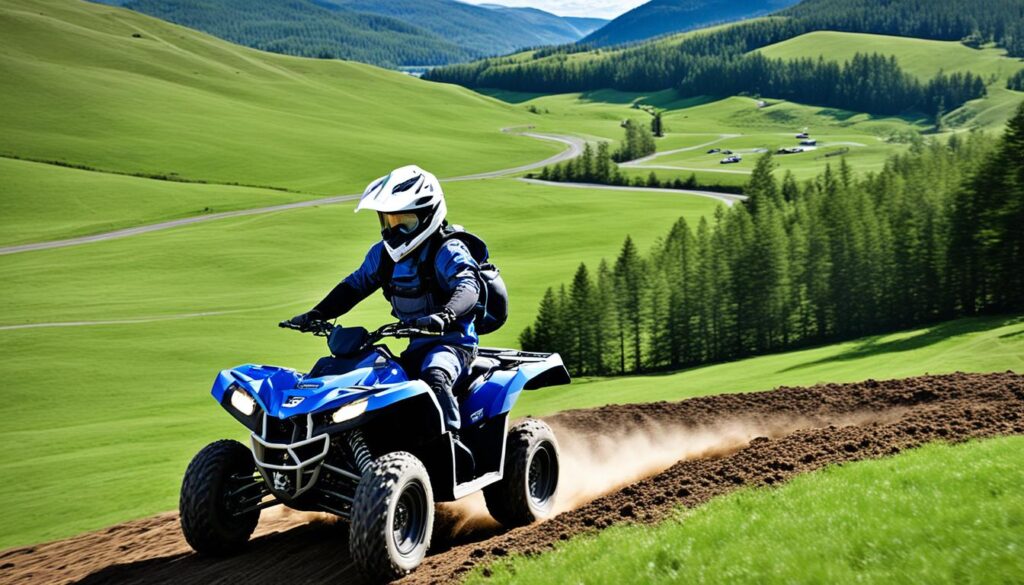
Next, we will delve into the importance of learning the throttle on your ATV, covering crucial tips and techniques to help you master this essential skill. Stay tuned!
Learning the Throttle on Your ATV
Familiarizing yourself with the throttle on your ATV is essential for beginners. The throttle is responsible for controlling the acceleration and speed of your ATV, so understanding how to use it effectively is crucial for a safe and enjoyable riding experience.
When you first start riding, it’s important to take it slow. Gradually increase the throttle and get a feel for how your ATV responds. This will allow you to build confidence and prevent accidents caused by sudden acceleration.
To optimize the performance of your ATV, consider using high-test gasoline. This type of fuel is specially formulated to provide better acceleration and power, ensuring a smoother ride.
Proper thumb throttle control is also key to maintaining stability while riding. Keep your thumb positioned on the throttle and avoid gripping it too tightly. A relaxed grip allows for smoother control and prevents unnecessary jerking or sudden changes in speed.
Remember, mastering ATV throttle control takes practice. As you gain experience and become more comfortable with your ATV, you’ll be able to manipulate the throttle with precision, enabling you to navigate various terrains and obstacles with ease.
ATV Throttle Tips:
- Start slow and gradually increase speed to build confidence.
- Use high-test gasoline for optimized performance.
- Maintain a relaxed grip on the throttle for smoother control.
- Practice manipulating the throttle to navigate diverse terrains.
By learning how to effectively use the throttle on your ATV, you’ll be able to accelerate safely and control your ATV with confidence, enhancing your overall riding experience.
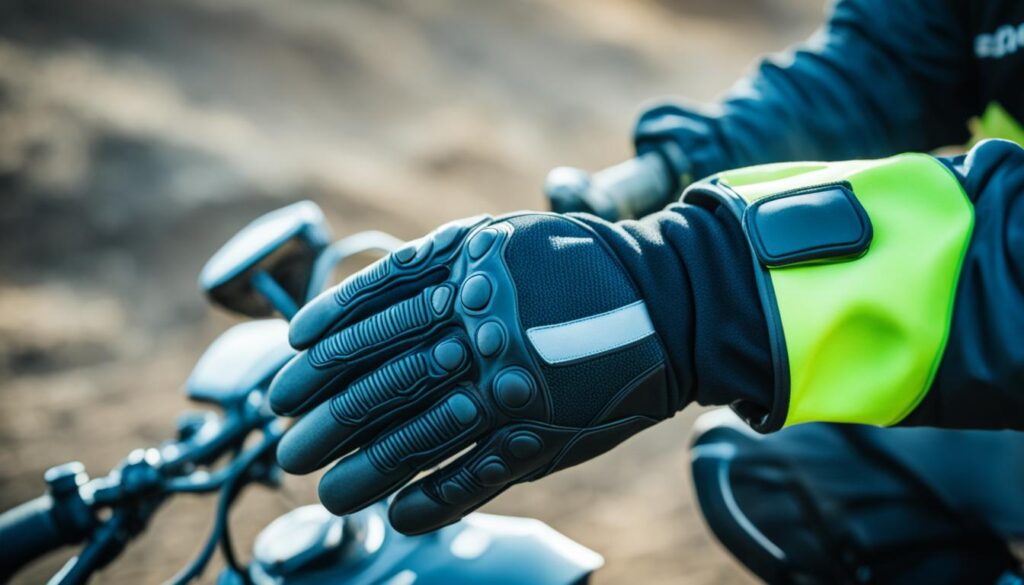
Always Wear Your ATV Riding Gear
When it comes to ATV safety, wearing the right gear is absolutely vital. As a beginner, it’s important to understand the importance of protecting yourself while enjoying your ATV adventures. Investing in the appropriate ATV riding gear can significantly reduce the risk of injuries and ensure a safer riding experience.
Here are some essential pieces of riding gear that every ATV enthusiast should have:
| ATV Riding Gear | Description |
|---|---|
| Protective Jacket | A durable and armored jacket that provides protection for your upper body, including shoulders, elbows, and back. |
| Ankle-covering Boots | Sturdy boots that cover and protect your ankles, providing stability and support while riding. |
| DOT-Certified Helmet | A high-quality helmet that meets DOT standards, protecting your head from potential impact and reducing the risk of head injuries. |
| Gloves | Comfortable and durable gloves that provide grip, protection, and control while operating your ATV. |
| Goggles | Protective eyewear that shields your eyes from debris, dust, and wind, ensuring clear vision during your ride. |
| Chest Protector | An essential piece of gear that safeguards your chest and upper body from potential impacts and flying debris. |
| Knee/Shin Guards | Protective gear that shields your knees and shins from injury, providing additional safety and support. |
Remember, safety should be your top priority whenever you hop on your ATV. It’s worth investing in high-quality gear to ensure your well-being and enjoy your rides with peace of mind.
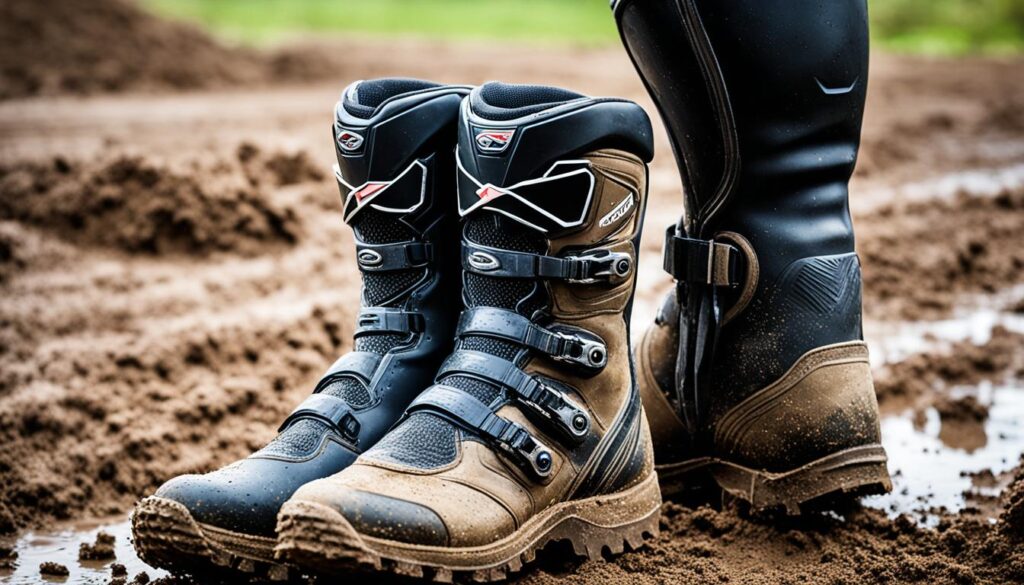
Having the right ATV riding gear not only protects you from potential accidents but also enhances your overall comfort and riding experience. Don’t compromise on safety, make sure to gear up properly before embarking on your ATV adventures.
Learn About ATV Shifting
When it comes to ATVs with manual shifting, understanding the gear shifting process is vital for beginners. By practicing changing gears and becoming familiar with the controls, you can ensure a smooth and controlled ride. Let’s explore some essential tips to help you master ATV shifting and improve your overall riding experience.
Throttle and Clutch Control
Learning the finesse required for throttle and clutch control is crucial when it comes to ATV shifting. The throttle controls the engine’s power, while the clutch allows you to engage and disengage power transmission to the wheels. To prevent stalling, it’s essential to find the right balance and coordination between the throttle and clutch when shifting gears. Practice controlling both the throttle and clutch simultaneously to smoothen your gear transitions and enhance your ATV riding skills.
Mastery through Practice
Just like any new skill, mastering ATV shifting requires practice and becoming comfortable with your ATV’s gearing and controls. Start by practicing shifting gears in a controlled environment, such as an empty parking lot or off-road trail. Take the time to understand how your ATV’s transmission responds to gear changes, and gradually build your confidence by practicing different shifting techniques. With practice, you’ll become more proficient and efficient in shifting gears, making your ATV rides more enjoyable.
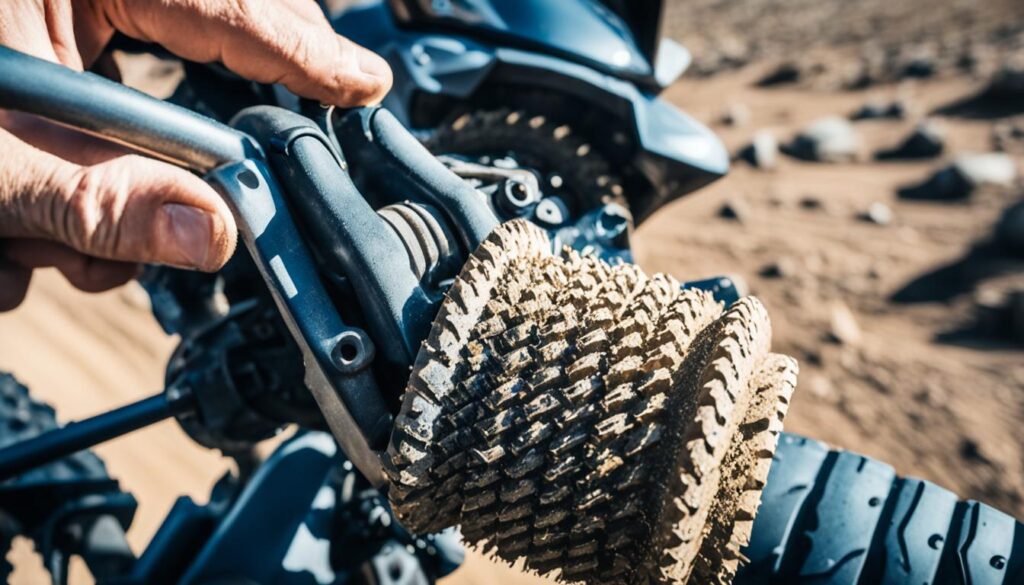
Tips for Smooth Shifting
Here are some additional tips to help you improve your ATV shifting skills:
- Master the timing of shifting to avoid excessive revving or lugging the engine.
- Anticipate gear changes based on the terrain and your riding style.
- Use the clutch smoothly and avoid abrupt engagements or disengagements.
- Practice downshifting to effectively control your ATV’s speed during descents.
- Maintain a relaxed grip on the handlebars to minimize unintentional throttle inputs.
| Common ATV Shifting Mistakes | Tips to Improve |
|---|---|
| Stalling the engine while changing gears | Practice simultaneous throttle and clutch control |
| Rushing gear changes, resulting in rough shifts | Focus on smooth and deliberate gear transitions |
| Failure to anticipate gear changes for optimal performance | Experiment with different gear ratios in varying terrain |
| Forgetting to downshift during downhill sections | Practice downshifting to maintain control and prevent brake overheating |
“By mastering ATV shifting, you can unlock the full potential of your ATV and enhance your overall riding experience.” – [Your Name]
With practice, patience, and a thorough understanding of your ATV’s gearing and controls, you’ll gain confidence in your shifting abilities. Proper ATV shifting will not only improve your riding skills but also contribute to a safe and enjoyable ATV adventure. Continue to explore the world of ATVing and discover the thrill of manual shifting on ATVs.
ATV Posture and Riding Positions
Developing proper ATV posture and riding positions is essential for beginners. By adopting the correct posture and understanding how to position yourself on the ATV, you can enhance your control, stability, and overall riding experience.
Leaning Away from the Curve
One crucial technique for maintaining control while navigating curves is to lean away from the direction of the turn. This helps to balance the weight distribution of the ATV and prevent it from tipping over. Remember to keep your body upright and avoid leaning into the curve, as this can lead to instability.
Distributing Weight for Effective Steering
Proper weight distribution plays a significant role in steering an ATV. When turning, shift your body weight towards the outside footpeg to initiate the turn smoothly. This action shifts the center of gravity, improving stability and control. By distributing weight effectively, you can minimize the risk of losing control or getting stuck in challenging terrain.
Knowing When to Hover
There are situations where standing up or hovering on your ATV can provide better visibility and control. Standing up helps absorb the impact of bumps and allows you to navigate rough terrain more effectively. Additionally, it provides a clearer line of sight, enabling you to anticipate obstacles ahead and react accordingly.
Staying Loose and Absorbing Terrain Movement
When riding an ATV, it’s crucial to maintain a relaxed and loose posture to absorb the movement of the terrain. Flex your knees and elbows slightly to act as natural shock absorbers, allowing the ATV to move beneath you. This technique helps to minimize fatigue and enhances your ability to maneuver the ATV in various conditions.
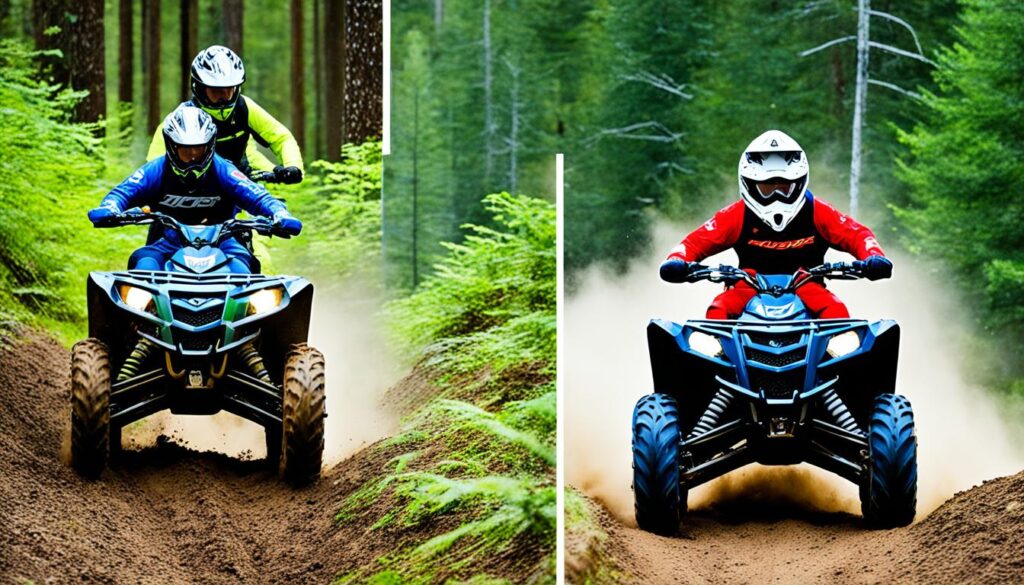
Incorporating these ATV riding positions and maintaining proper posture will not only improve your control and stability but also reduce the risk of accidents. By staying mindful of your body positioning and weight distribution, you can confidently tackle different terrains and enjoy a safer and more enjoyable ATV riding experience.
ATV Practice Makes Perfect
Consistent practice is vital for beginners to become skilled and confident ATV riders. By dedicating time to practicing and honing your ATV skills, you can improve your riding abilities and master the basics of ATVing.
Setting goals for practice rides is a great way to stay motivated and track your progress. Whether it’s mastering a specific riding maneuver or becoming more comfortable with ATV controls, having a clear objective can help you focus your practice sessions.
Isolating and improving specific skills or maneuvers is another effective approach. For example, if you’re struggling with tight turns, focus on practicing that specific maneuver until you feel more confident and comfortable.
Gradually increasing your proficiency over time is key. Start with simple exercises and gradually challenge yourself with more complex maneuvers as you gain confidence and experience. Consistency is key, so try to incorporate regular practice sessions into your ATVing routine.
Practicing on various terrains can also enhance your skills. Different terrains offer unique challenges, such as mud, sand, or rocky trails. By exposing yourself to different environments, you can become a more versatile rider and adapt to different riding conditions.
Becoming comfortable with ATV controls is crucial for mastering ATV basics. Take the time to familiarize yourself with the various buttons, switches, and levers on your ATV. Practice using them effectively and efficiently to ensure smooth and controlled maneuvering.
Remember, improving your ATV riding skills takes time and patience. Be patient with yourself and celebrate small victories along the way. With consistent practice, determination, and a focus on mastering the basics, you’ll become a skilled and confident ATV rider in no time.
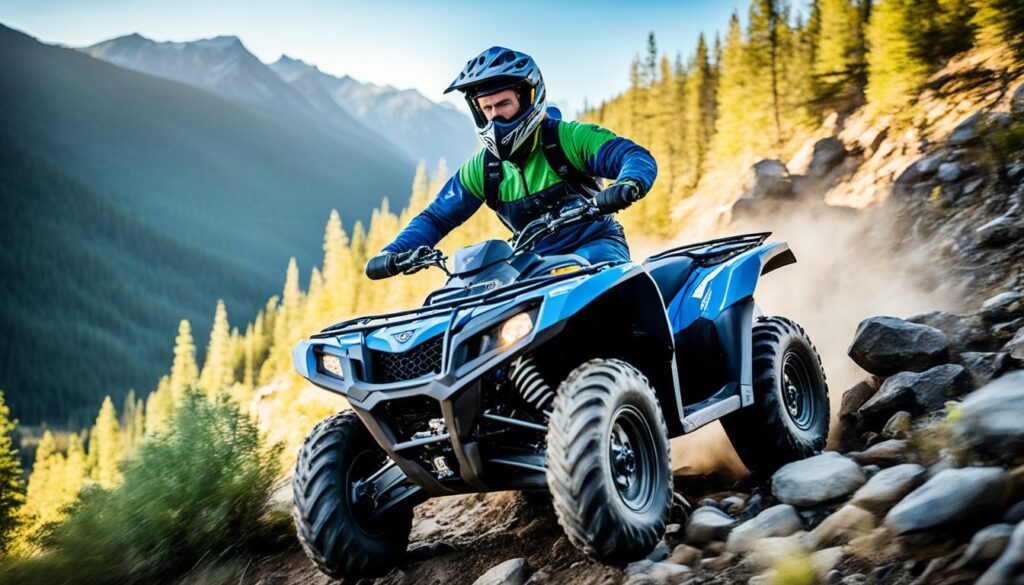
Tips for Improving ATV Riding Skills:
- Set goals for practice rides
- Isolate and improve specific skills or maneuvers
- Gradually increase proficiency over time
- Practice on various terrains
- Become comfortable with ATV controls
Choosing the Right ATV Model
Selecting the appropriate ATV model for beginners is crucial. Starting with a simpler model, such as the Can-Am ATV, allows for easier familiarization and learning. When choosing an ATV, it’s important to consider factors like size and comfort to ensure a safe and enjoyable riding experience.
Why Start with a Simpler Model?
Beginning your ATV journey with a model specifically designed for beginners can help ease you into the world of off-roading. Simpler models often have user-friendly features and intuitive controls, making it easier to get comfortable with operating an ATV. The Can-Am ATV, for example, offers a range of models suitable for beginners, providing a smooth and controlled riding experience.
Ensuring Size and Comfort
When choosing an ATV for beginners, consider the size that suits your body type and riding needs. An ATV that is too large or too small can affect your comfort and riding confidence. It’s essential to find the right balance between maneuverability and stability. The Can-Am ATV lineup offers various sizes, allowing you to select the one that fits you best.
Comfort is another crucial aspect to consider. Look for an ATV with a comfortable seat and ergonomic design that reduces fatigue during long rides. The Can-Am ATV models prioritize rider comfort, with features like adjustable suspension systems and enhanced ergonomics.
To get a better idea of the Can-Am ATV models available for beginners, take a look at the table below:
| ATV Model | Description |
|---|---|
| Can-Am Outlander 450 | A versatile and reliable ATV with a compact size, perfect for beginners. |
| Can-Am DS 250 | An agile and easy-to-handle ATV specifically designed for entry-level riders. |
| Can-Am Renegade 570 | A powerful and dynamic ATV that offers a balanced combination of performance and usability. |
Remember, choosing the right ATV model is essential for beginners to ensure a smooth and enjoyable riding experience. Starting with a simpler model like the Can-Am ATV allows you to learn and build confidence while prioritizing your comfort and safety.
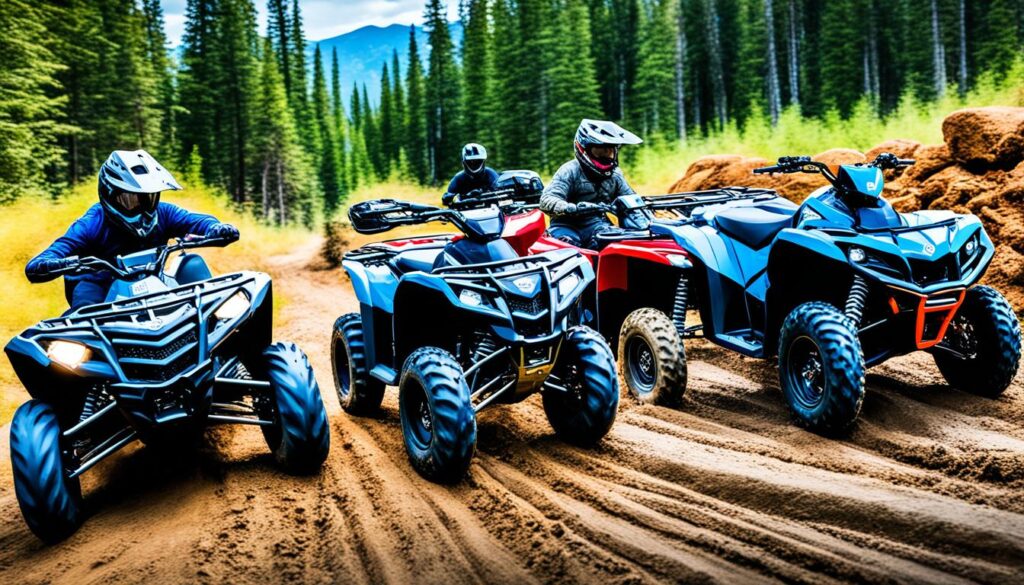
Educating Yourself on ATV Features
Before you take your ATV out for a spin, it’s crucial to familiarize yourself with its specific features and functionality. This knowledge will not only enhance your riding experience but also contribute to your safety on the trails.
To start, I recommend thoroughly reading the owner’s manual. The manual provides detailed information about your ATV’s components, controls, and maintenance requirements. Pay close attention to sections that cover important safety features and operating procedures. Understanding this information will help you make informed decisions while operating your ATV and prevent any avoidable mishaps.
Taking a safety course is another valuable step in ATV education. These courses, such as those offered by reputable organizations like the ATV Safety Institute (ASI), provide comprehensive training on ATV operation, safety practices, and emergency preparedness. The hands-on experience offered during these courses can significantly improve your confidence and competence as a rider.
Additionally, seeking guidance from an experienced ATV rider can offer invaluable insights. Reach out to friends, family members, or local riding communities for advice and information. Experienced riders can provide practical tips and tricks, share their expertise on specific ATV models, and offer guidance on tackling different terrains.
Remember, education is the key to safe and responsible ATV riding. By educating yourself about your ATV’s important features and functionality, you can minimize risks and ensure an enjoyable riding experience.
Now that we’ve covered the importance of ATV education, let’s move on to other aspects of ATV safety and riding techniques. In the next section, we will discuss the significance of wearing proper riding gear and the essential items you should have before hitting the trails.
Conclusion
By prioritizing ATV safety, mastering throttle control, wearing proper protective gear, practicing correct posture, and consistently improving riding skills, beginners can confidently enjoy the thrilling adventure of ATVing. With dedication and patience, novice riders can become skilled and confident ATV enthusiasts while ensuring safety is always a top priority.
ATVing as a beginner requires a thorough understanding of safety guidelines and basic techniques. It is essential to invest time in proper education and training, including reading the owner’s manual, taking an ATV safety course, and seeking guidance from experienced riders. These steps will equip beginners with the knowledge necessary to avoid common mistakes and ride responsibly.
Ultimately, the joy and excitement of ATVing can be fully experienced by following the essential tips and basics discussed in this beginner’s guide. Through consistent practice, new riders can master ATV riding, explore different terrains, and create unforgettable memories while staying safe on the trails. Embracing the adventure of ATVing as a beginner is a journey filled with both challenges and rewards.
FAQ
What are some essential tips and basics for ATVing beginners?
ATV beginners should prioritize safety, master throttle control, wear protective gear, practice proper posture, and consistently practice and improve their skills.
What are some ATV safety basics that beginners should know?
Beginners should educate themselves on ATV safety basics such as familiarizing themselves with the owner’s manual, investing in ATV safety training, wearing protective gear, and being aware of any ATV restrictions in their area.
How can beginners learn to control the throttle on their ATV?
Beginners can start by familiarizing themselves with the throttle’s response, starting slowly and gradually increasing speed, and practicing proper thumb throttle control.
What kind of riding gear should beginners wear for ATVing?
Beginner ATV riders should wear a protective jacket, boots that cover the ankles, a DOT-certified helmet, gloves, goggles, chest protector, and knee/shin guards.
How can beginners learn about ATV shifting?
Beginners can practice changing gears and becoming familiar with the controls. It is important to understand throttle and clutch control for proper shifting.
What is the importance of proper ATV posture and riding positions?
Proper ATV posture and riding positions are important for maintaining control and preventing accidents. Leaning away from curves and distributing weight to steer the ATV effectively are crucial techniques.
How can beginners practice and improve their ATV riding skills?
Beginners can set goals for practice rides, isolate and improve specific skills or maneuvers, and gradually increase proficiency over time. Practice on various terrains and becoming comfortable with ATV controls are key to improvement.
How should beginners choose the right ATV model?
Beginners should start with a simpler ATV model, ensuring the size provides comfort and confidence while riding.
How can beginners educate themselves on the features of their ATV?
Beginners should thoroughly read the owner’s manual, consider taking a safety course, and receive guidance from an experienced ATV rider to learn about their ATV’s specific features and functionality.
What is the key takeaway for ATVing beginners?
By following the essential tips and basics for ATVing as a beginner, prioritizing safety, mastering throttle control, wearing protective gear, practicing proper posture, and consistently practicing and improving skills, beginners can embark on a thrilling ATV adventure with confidence.
